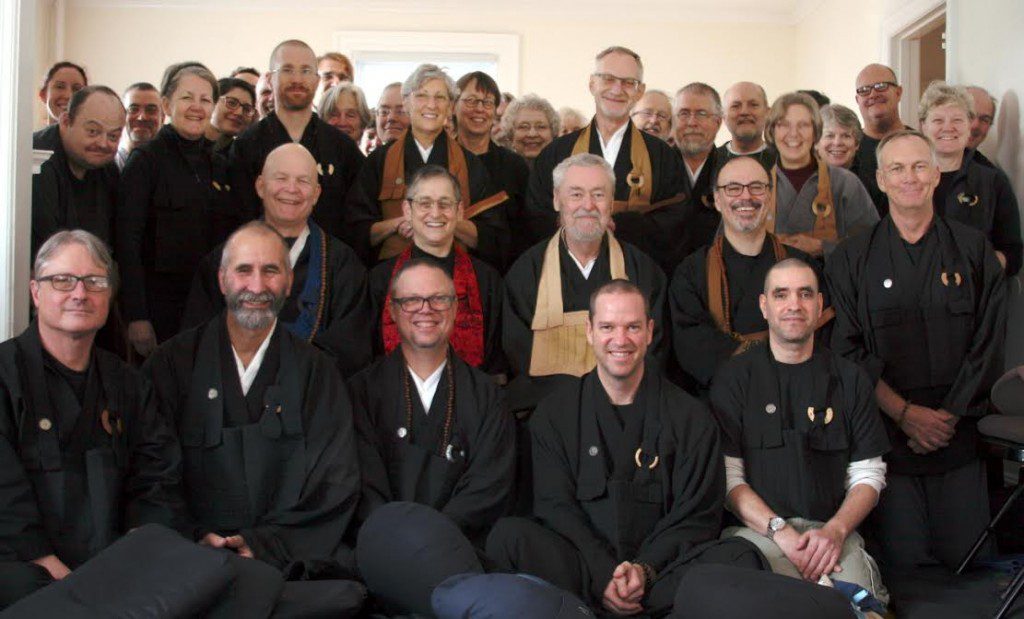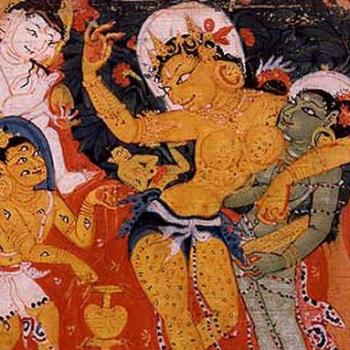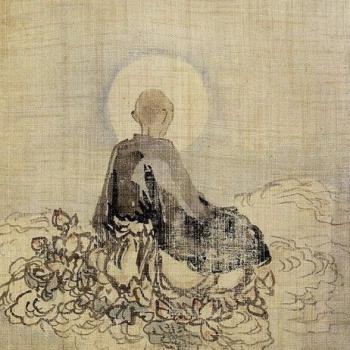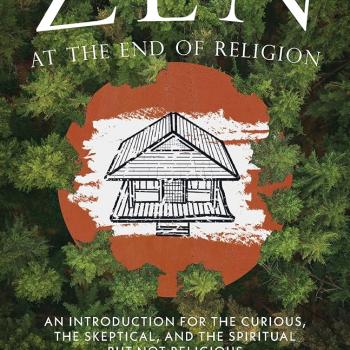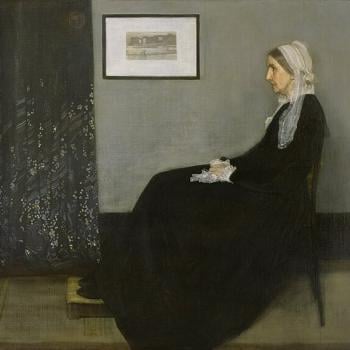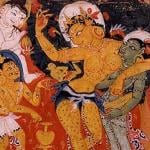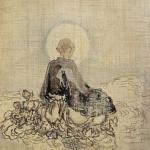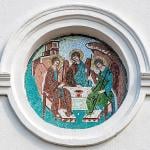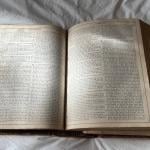These two pictures show our Boundless Way revealing its heart. The first picture is from today of forty of us marking the end of our annual Rohatsu or Bodhi Day celebration sesshin (“to touch the heart-mind,” an intensive Zen meditation retreat) at the Boundless Way Temple in Worcester, Massachusetts. The temple in Worcester is the first real estate to be owned by a member community of Boundless Way Zen, the Zen project to which I give my heart and energy. Me, I think of the temple as our mother ship.
The second picture is of our nine transmitted teachers who were there to witness as Dr James Cordova received denbo transmission from our current school abbot Melissa Myozen Blacker. It was a powerful moment for me for many reasons. Not least as James is Melissa’s first full Dharma successor, and she is my first heir. This led me to a revery considering who we are and how we have come to be the Boundless Way. What follows is that reflection.
The great project of Zen is awakening. Boundless Way Zen is committed to that project with the fulness of our being. We have given a lot of attention to how we can best foster the project, exploring what is important, sorting out what is less so, exploring our practices, and our relationships. We formulated our mission to cultivate Zen in the West with three points: 1) Establishing and supporting local sanghas. 2) Training dharma teachers and practice leaders. and 3) Providing sesshin and other intensive training opportunities. And now some years into it we can see the contours of an emerging Zen style, a Zen that is both authentic and Western.
It all started some fifteen or sixteen years ago. As with many important things it is hard to put a finger on precisely when to say it began. Or, even the precise moment when those events took place. Still, there are some markers. Boundless Way was created when three independent sitting groups, Spring Hill Zen in Somerville, Henry David Thoreau Zen Sangha in Newton, and the Worcester Zen Community came together as the leaders of those communities, Josh Bartok, Melissa Blacker, David Rynick, and I threw our lot in with each other. We had been working together informally for a while. But it became something more focused sometime in 2004 or 2005, when as David Rynick recalls, I came to visit him and Melissa and proposed “that the three of us join together and create a new organization.” A lot has happened since that meeting eleven or twelve years ago.
While I was more senior, each of us had teaching credentials, and Melissa, David and I were the founding teachers working collaboratively. Josh, while himself not yet a teacher was from the beginning making leadership contributions, and we all cherished the energy of the Spring Hill sangha and saw Josh’s contributions as critical to our emerging vision, including as just one example becoming principal editor for our liturgy.
Melissa had previously studied for some twenty years with the independent teacher Richard Clarke who had been early on associated with Philip Kapleau and taught in his “Rochester” style. David was a senior student of George Bowman who had been the first person authorized as a teacher by Seung Sahn of the Kwan Um School of Zen, but was now teaching independently, as well. Josh Bartok had previously been a student of Daido Loori. And, me, I had originally studied with Jiyu Kennett and had been ordained a Soto priest by her and received her Dharma transmission in 1971, then studied for many years with John Tarrant as well as a few other Diamond Sangha teachers, and in 2005 received Inka Shomei from him.
Although already leading groups Melissa and Josh both formally took me on as their teacher, while David finished his formal training with George Bowman. Melissa, David, and I joined together as the guiding teachers council, all of us sitting regularly together and from before even the beginning of our being “Boundless Way,” began offering sesshin, three, five, and seven day intensive meditation retreats. In 2006, I fully authorized Melissa and David received the first step in his authorization from George Bowman. In 2011, George gave David his final transmission in the Korean Rinzai line. In the same year I ordained David a Soto Zen priest.
And then in 2012 I authorized Josh, and with that our guiding teachers council was then four. As I see it this was our second founding, a critical moment for our sangha ranking with the purchase of what would become the Boundless Way temple, as a major step in our maturing. Melissa, David, and I had to let go of a very deep intimacy we’d grown to enjoy as the guiding teachers, and open ourselves to Josh as a full equal. Now, the reality was we’d been for some time three plus one, so the step into a full four was not as hard as this might sound. But, it was hard. And it was critical. And, it turned out to be magic, enriching each of us, and our increasingly beloved Boundless Way. I gave Melissa Inka in 2010. And in 2016 I gave David and later that same year I gave Josh Inka.
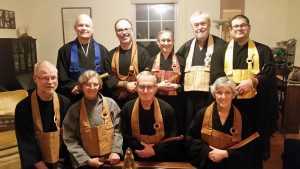 Our project as Boundless Way was to create an authentic Zen transmission within a Western expression. Along the way our understanding of the critical practices gradually matured. Today we principally offer the ancient Zen disciplines of just sitting, called shikantaza by Dogen, and koan introspection.
Our project as Boundless Way was to create an authentic Zen transmission within a Western expression. Along the way our understanding of the critical practices gradually matured. Today we principally offer the ancient Zen disciplines of just sitting, called shikantaza by Dogen, and koan introspection.
And here just a pause. While this reflection is largely about the institution and particularly leadership and teaching, the purpose of this project is awakening. And those other things are all about supporting our full exploration of who we are as we are. To come into Zen is not about the leadership aspect. It is about practicing, opening ourselves, digging deep, diving deep, and with that living lives of care and respect and possibility.
That acknowledged, my thoughts here are about the institution and our leadership, particularly our spiritual leadership. Here we have begun to see something take shape unique to who we are. Our general style of spiritual direction has been enriched by Melissa’s education and practice as a counseling psychologist specializing in grief and trauma, and her extensive experience and 20 year close affiliation as a core faculty person with Jon Kabat-Zinn’s Mindfulness Based Stress Reduction program at the University of Massachusetts Medical School in Worcester. David also had a solid grounding in mindfulness, although it was his experience with experimental education and organizational leadership development, and later life coaching skills that would prove critical for us. And Josh’s influence is born, in part, from his ongoing exploration of the role of nondual faith, true entrusting, and deep acceptance in Zen, informed by his study of Shin Buddhism with Tai and Mark Unno, as well as his editorial work with scores of diverse Dharma teachers on hundreds of Buddhist books. Melissa’s, David’s, and my own close associations with American Unitarian Universalism, inclined us to create as flat a hierarchy as we felt reasonable while still conveying an authentic Zen practice with genuinely empowered teachers. This association with the UU world has also led us to be concerned with how our spiritual lives manifest in the world and a number of us fit comfortably or for some uncomfortably within the warm embrace of Engaged Buddhism.
Along the way bylaws were created, and we incorporated as a religious organization. Also, mindful of how ethics and accountability had been largely ignored in the early history of Zen in the West, including within our own lineages, and terribly hurting many people, we created a practical ethics code that has become a template for a number of Zen communities. Gradually various practice communities emerged until we came to be about a dozen groups ranging throughout New England. And now, as our mission to the Western barbarians we have a California branch, the Blue Cliff Zen Sangha which I guide together with Jan Seymour-Ford and Chris Hoff is the youngest affiliate of Boundless Way. In addition to our official Boundless Way network we’ve forged close ties with other teachers and communities, particularly in Ohio, and Connecticut.
We also decided to fully embrace the Soto Zen priesthood that I had received through Jiyu Kennett, although revisioning the training expectations, stepping away from requiring a monastic experience, although supporting it when appropriate to the student’s life, family, and work and substituting as a hard expectation a rigorous experience with retreat, assuming a minimum of a year of sesshin days (nine or ten hours of meditation a day) as well as engaging the Harada Yasutani Soto reform of the Hakuin Takujo koan curriculum – itself slightly modified through an appreciation of the koan system developed by Seung Sahn. Following our own peculiar lights we have in some ways come to look similar to the White Plum Asanga, but definitely with our own flavor and systems of accountability.
Our lay teachers train over many years through many sesshin and that koan program. Our ordained training program is a work in progress, although it also has at its center those same sesshin and koan introspection – with somewhat different focus for each individual, some more resonant with shikantaza, while others more aligned with koan study. At first we simply saw ordination as ministry, a path of service. But, over these past few years we have come to see there is something else within it. Ordination has taken on a quality for us that is mysterious, and has qualities that look a lot like Christian “third order” societies. We are following our hearts into something powerful and compelling, even as we are unclear as to precisely where it is taking us, but it is looking like some kind of non celibate religious order. Without having the numbers in front of me as I write, I’d hazard we have about twenty priests.
Guided by our senior teachers council our Boundless Way has continued to grow, in depth, and breadth. And we have engaged the larger Zen and Buddhist world as it is emerging here in the West, particularly North America. Our first four core teachers have all contributed to the literature of Zen practice here in the West writing and editing books as well as contributing to all the principal Buddhist journals. Melissa, David, Josh, and I have all been active in the American Zen Teachers Association. James Cordova has been active with the American Lay Zen Teachers Association. And I have been active with the Soto Zen Buddhist Association.
I’m in awe of what has emerged in a scant fifteen years. In addition to the Boundless Way Temple, our sangha includes the Greater Boston Zen Center, Benevolent Street Zendo, Boundless Way DownEast, Boundless Way Zen Northampton, Boundless Way Zen of Westchester, Bright Sea Zen, Henry David Thoreau Zen, Joseph Priestly Zen Sangha, Morning Star Sangha, Mustard Seed Sangha, and of course, the baby, our Blue Cliff in Long Beach.
Our style offers a three step transmission. We authorize both lay people and priests as teachers. As with Zen in the West transmitting the Bodhisattva ordination system derived from Japan it isn’t always clear what the difference between a layperson and a priest is. Elsewhere here I speak of how we’re exploring ordination and its meanings for us. So, just the quickest thought on lay practice. In the last analysis for me there is only Zen practice, although it may take on different focus in our lives at different times.
The first step in transmission is Denkai, or precepts transmission, which for priests is full ordination and for both priests and lay people authorization to take personal students, to give the precepts, and do all teaching functions, save one. They do not have authority to make new teachers. That comes with the second, or full authorization, denbo. We use the traditional Sanmatsu (the “three things”) transmission documents of Soto Zen to mark these occasions. The only difference is that only priests receive the kiragami (“bits of paper”) documents which are largely concerned with liturgical matters. Although we have begun discussing passing on non liturgical parts of this collection to our lay teachers.
Denbo is the most important of the authorizations. At that point someone is considered a free actor and the transmission cannot be revoked. Although one could be dismissed from the organization and the teacher who gave transmission could express regret, the authorization is tied into the great mystery of Zen’s transmission. And one more important point.
Once someone has been given denbo the senior guiding teachers may nominate that person to also become a senior guiding teacher of Boundless Way. But that can only occur through election by the Leadership council, itself the elected governing board of Boundless Way, which includes teachers and lay representatives.
The third step in transmission is Inka Shomei, “formal recognition of realization.” While one is fully an independent teacher with Denbo, out of respect for the special transmissions we received through John Tarrant and George Bowman, and which are specifically associated with completion of formal koan study and full independence as masters of that discipline, we continue the tradition of Inka. For us it becomes a marker of stability in teaching and at this point, at least, occurs at the discretion of the transmitting teacher a minimum of three years after denbo.
We also have flattened the structures for leadership, authorizing people at less than transmitted levels. We draw titles for these teachers from the Kwan Um, calling them dharma teachers and senior dharma teachers. These are mature practitioners who have taken on various leadership roles in our community, and for the senior dharma teachers usually includes authorization to do practice interviews and sometimes koan instruction – although still under the guidance of transmitted teachers.
At this writing we have nine transmitted teachers, and one more in the final steps toward formal authorization. We have four denkai teachers, Steve Wallace, Kate Hartland, Bob Waldinger, and Diane Fitzgerald. Today James Cordova received denbo, joining our four seniors all of whom also have inka, Melissa Blacker, David Rynick, Josh Bartok, and me. Steve, Kate, and James are lay teachers. Michael Fieleke, one of our priests, will be receiving denkai sometime in the next six months.
In addition to having non-transmitted teachers, we have included other innovations for our transmitted teachers. While we maintain the tradition of a single teacher authorizing a single student, we have embraced the principal of communal responsibility modeled by the Kwan Um school, and up to this point everyone who received denkai or denbo within Boundless Way has been endorsed by all the other transmitted teachers.
Anticipating the denbo ceremony the leadership council elected James Cordova to our senior guiding teachers council, effective with the transmission ceremony. So, now as five, and actually as both Kate and Diane are in the process which will soon lead to their receiving denbo and therefore will both be eligible to be elected to the guiding teachers council, if it isn’t already so, we will soon be too big to continue this practice in its current form and have begun discussing how we might best go forward, perhaps with any three or five teachers doing the endorsement.
Our commitment to work with each other is so important, and is probably the secret. Through our commitment we support and protect each other from the inherent dangers of being a spiritual leader. And, frankly, for us to acknowledge with that commitment comes hard work, which we now have done for years. And it continues. It means we have all had to do the personal work necessary to stay in relationship. It has been our ongoing commitment to be present to each other as we really are, and our willingness to deal with what arises that has made it work so far. And, for the future it is critical to keep extending the invitation to others. This I find very important to our way.
This is the Boundless Way. It is the Boundless Way for our teachers, and it is the Boundless Way for all of us who desire to walk the way with authenticity. And so we continue to engage in conversation and reflection, and hope as we seem to continue to grow, that what we offer remains healthy, transparent, and authentic – combining the ancient traditions which we revere and living fully into our contemporary culture.
And while we are still growing, still finding the fulness of what we are and what we can offer, I believe even now we are well placed and prepared to be of use as the storm rages.
I am so grateful.
James Myoun Ford
Boundless Way Zen
4 December 2016
(The first version of this reflection was written in the afternoon of the 4th of December, while at Logan Airport in Boston waiting to return to California following the Rohatsu sesshin. Numerous edits and some substantial revisions followed over the next two days. This has changed what was written sufficiently, that I’ve decided to give it a new title.)


